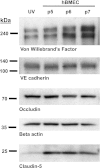Interleukin-1β-induced barrier dysfunction is signaled through PKC-θ in human brain microvascular endothelium
- PMID: 22403784
- PMCID: PMC3362001
- DOI: 10.1152/ajpcell.00371.2011
Interleukin-1β-induced barrier dysfunction is signaled through PKC-θ in human brain microvascular endothelium
Abstract
Blood-brain barrier dysfunction is a serious consequence of inflammatory brain diseases, cerebral infections, and trauma. The proinflammatory cytokine interleukin (IL)-1β is central to neuroinflammation and contributes to brain microvascular leakage and edema formation. Although it is well known that IL-1β exposure directly induces hyperpermeability in brain microvascular endothelium, the molecular mechanisms mediating this response are not completely understood. In the present study, we found that exposure of the human brain microvascular endothelium to IL-1β triggered activation of novel PKC isoforms δ, μ, and θ, followed by decreased transendothelial electrical resistance (TER). The IL-1β-induced decrease in TER was prevented by small hairpin RNA silencing of PKC-θ or by treatment with the isoform-selective PKC inhibitor Gö6976 but not by PKC inhibitors that are selective for all PKC isoforms other than PKC-θ. Decreased TER coincided with increased phosphorylation of regulatory myosin light chain and with increased proapoptotic signaling indicated by decreased uptake of mitotracker red in response to IL-1β treatment. However, neither of these observed effects were prevented by Gö6976 treatment, indicating lack of causality with respect to decreased TER. Instead, our data indicated that the mechanism of decreased TER involves PKC-θ-dependent phosphorylation of the tight junction protein zona occludens (ZO)-1. Because IL-1β is a central inflammatory mediator, our interpretation is that inhibition of PKC-θ or inhibition of ZO-1 phosphorylation could be viable strategies for preventing blood-brain barrier dysfunction under a variety of neuroinflammatory conditions.
Figures








References
-
- Abbott NJ, Patabendige AA, Dolman DE, Yusof SR, Begley DJ. Structure and function of the blood-brain barrier. Neurobiol Dis 37: 13– 25, 2010 - PubMed
-
- Aiello LP, Bursell SE, Clermont A, Duh E, Ishii H, Takagi C, Mori F, Ciulla TA, Ways K, Jirousek M, Smith LE, King GL. Vascular endothelial growth factor-induced retinal permeability is mediated by protein kinase C in vivo and suppressed by an orally effective beta-isoform-selective inhibitor. Diabetes 46: 1473– 1480, 1997 - PubMed
-
- Aiello LP, Clermont A, Arora V, Davis MD, Sheetz MJ, Bursell SE. Inhibition of PKC beta by oral administration of ruboxistaurin is well tolerated and ameliorates diabetes-induced retinal hemodynamic abnormalities in patients. Invest Ophthalmol Vis Sci 47: 86– 92, 2006 - PubMed
-
- Antonetti DA, Barber AJ, Hollinger LA, Wolpert EB, Gardner TW. Vascular endothelial growth factor induces rapid phosphorylation of tight junction proteins occludin and zonula occluden 1. A potential mechanism for vascular permeability in diabetic retinopathy and tumors. J Biol Chem 274: 23463– 23467, 1999 - PubMed
Publication types
MeSH terms
Substances
Grants and funding
LinkOut - more resources
Full Text Sources
Research Materials

